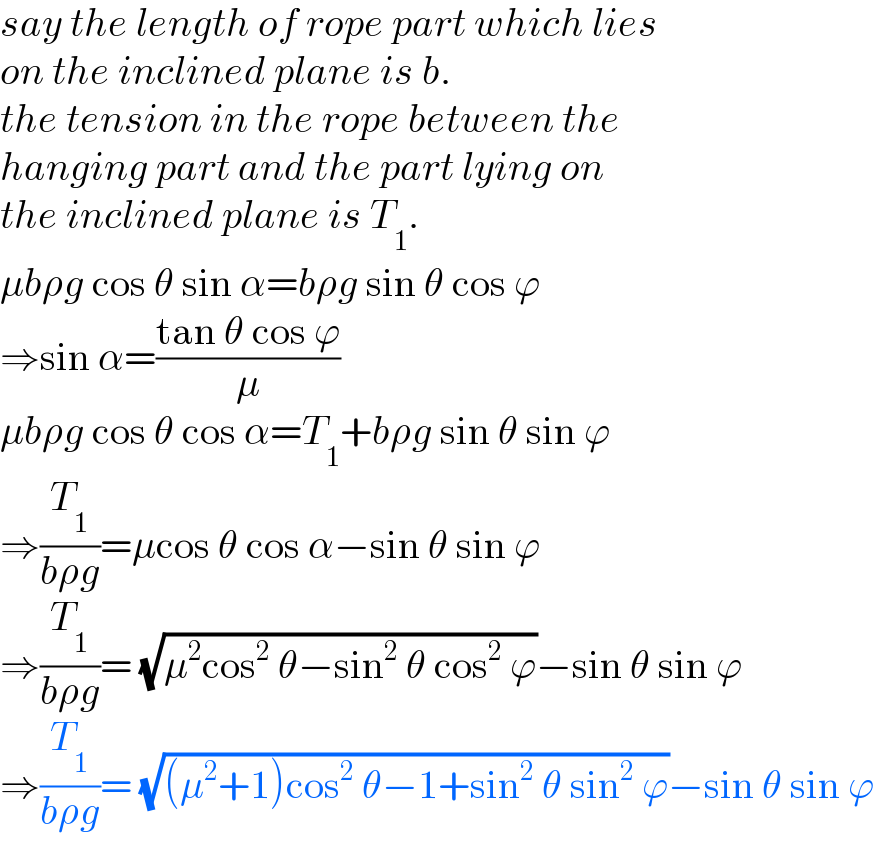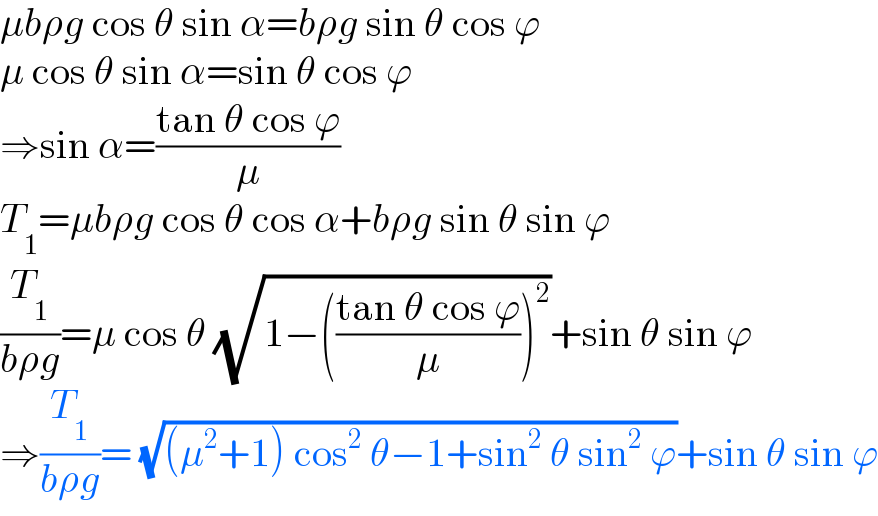
Question and Answers Forum
Question Number 177446 by mr W last updated on 05/Oct/22

Commented by mr W last updated on 05/Oct/22

Answered by mr W last updated on 06/Oct/22

Commented by mr W last updated on 06/Oct/22

Commented by mr W last updated on 06/Oct/22

Commented by mr W last updated on 07/Oct/22

Commented by mr W last updated on 07/Oct/22
![let η=(h/L), ξ=(b/L) sin φ=sin ϕ sin θ=λ, say a=(T_0 /(ρg))=((T_1 cos φ)/(ρg)) =b cos φ( (√((1+μ^2 )cos^2 θ−1+λ^2 ))−λ) =ξL(√(1−λ^2 ))((√((μ^2 +1)cos^2 θ−1+λ^2 ))−λ) let δ= (√((μ^2 +1)cos^2 θ−1+λ^2 ))−λ ⇒a=ξLδ (√(1−λ^2 )) eqn. of catenary in xy−system: y=a cosh (x/a) y′=sinh (x/a) s=a sinh (x/a) at point D: y′=sinh (d_1 /a)=tan φ ⇒(d_1 /a)=sinh^(−1) (tan φ)=sinh^(−1) (λ/( (√(1−λ^2 )))) h_2 =a cosh (d_1 /a)=a cosh (sinh^(−1) (λ/( (√(1−λ^2 ))))) =a (√(1+((λ/( (√(1−λ^2 )))))^2 ))=(a/( (√(1−λ^2 )))) s_1 =a tan φ=((aλ)/( (√(1−λ^2 )))) at point B: h_3 =a cosh (d_2 /a) s_2 =a sinh (d_2 /a) h_1 =h−h_3 (h_1 /a)=(h/a)−(h_3 /a) h_1 +h_2 =(d_1 +d_2 )tan φ ((h/a)−(h_3 /a)+(h_2 /a))((√(1−λ^2 ))/λ)=(d_1 /a)+(d_2 /a) ((h/a)−cosh (d_2 /a)+ (1/( (√(1−λ^2 )))))((√(1−λ^2 ))/λ)=sinh^(−1) (λ/( (√(1−λ^2 ))))+(d_2 /a) ((h/a)−cosh (d_2 /a))((√(1−λ^2 ))/λ)+ (1/( λ))=sinh^(−1) (λ/( (√(1−λ^2 ))))+(d_2 /a) (d_2 /a)+((√(1−λ^2 ))/λ) cosh (d_2 /a)=(1/λ)(((h(√(1−λ^2 )))/a)+1)−sinh^(−1) (λ/( (√(1−λ^2 )))) ⇒ λ((d_2 /a))+(√(1−λ^2 )) cosh (d_2 /a)=(η/(ξδ))+1−λ sinh^(−1) (λ/( (√(1−λ^2 )))) ...(i) s_1 +s_2 =L−b (s_1 /a)+(s_2 /a)=((L−b)/a) (λ/( (√(1−λ^2 ))))+sinh (d_2 /a)=((1−ξ)/(ξδ (√(1−λ^2 )))) sinh (d_2 /a)=(1/( (√(1−λ^2 ))))(((1−ξ)/(ξδ))−λ) ⇒(d_2 /a)=sinh^(−1) [ (1/( (√(1−λ^2 ))))(((1−ξ)/(ξδ))−λ)] ...(ii) insert (ii) into (i) we get an equation for solving ξ. r=AC=b+((d_1 +d_2 )/(cos φ)) =b+(a/(cos φ))((d_1 /a)+(d_2 /a)) =ξL+ξLδ{sinh^(−1) (λ/( (√(1−λ^2 ))))+sinh^(−1) [(1/( (√(1−λ^2 ))))(((1−ξ)/( ξδ))−λ) ]} ⇒ (r/L) =ξ+ξδ{sinh^(−1) (λ/( (√(1−λ^2 ))))+sinh^(−1) [(1/( (√(1−λ^2 )))) (((1−ξ)/( ξδ))−λ) ]} examples: μ=1.5, θ=30°, η=(h/L)=(3/5)=0.6, ϕ=0° ⇒ξ=(b/L)=0.1975, (r/L)=0.6556 ϕ=30° ⇒ξ=(b/L)=0.2556, (r/L)=0.7583 ϕ=60° ⇒ξ=(b/L)=0.3092, (r/L)=0.8551 ϕ=90° ⇒ξ=(b/L)=0.3320^(∗)) , (r/L)=0.8975 ∗) the same result as in Q170601](Q177531.png)
Commented by mr W last updated on 06/Oct/22

Commented by mr W last updated on 07/Oct/22

Commented by mr W last updated on 07/Oct/22

Commented by mr W last updated on 07/Oct/22

Commented by mr W last updated on 07/Oct/22

Commented by mr W last updated on 07/Oct/22
![let η=(h/L), ξ=(b/L) sin φ=sin ϕ sin θ=λ, say a=(T_0 /(ρg))=((T_1 cos φ)/(ρg)) =b cos φ( (√((1+μ^2 )cos^2 θ−1+λ^2 ))+λ) =ξL(√(1−λ^2 ))((√((μ^2 +1)cos^2 θ−1+λ^2 ))+λ) let δ= (√((μ^2 +1)cos^2 θ−1+λ^2 ))+λ ⇒a=ξLδ (√(1−λ^2 )) eqn. of catenary in xy−system: y=a cosh (x/a) y′=sinh (x/a) s=a sinh (x/a) at point D: y′=sinh (d_1 /a)=tan φ ⇒(d_1 /a)=sinh^(−1) (tan φ)=sinh^(−1) (λ/( (√(1−λ^2 )))) h_1 =a cosh (d_1 /a)=a cosh (sinh^(−1) (λ/( (√(1−λ^2 ))))) =a (√(1+((λ/( (√(1−λ^2 )))))^2 ))=(a/( (√(1−λ^2 )))) s_1 =a tan φ=((aλ)/( (√(1−λ^2 )))) at point B: h_1 +d_2 tan φ+h=a cosh ((d_1 +d_2 )/a) (h_1 /a)+(d_2 /a) tan φ+(h/a)=cosh ((d_1 +d_2 )/a) (1/( (√(1−λ^2 ))))+(η/(ξδ (√(1−λ^2 ))))=cosh ((d_2 /a)+sinh^(−1) (λ/( (√(1−λ^2 )))))−(d_2 /a)×(λ/( (√(1−λ^2 )))) ⇒(√(1−λ^2 ))cosh ((d_2 /a)+sinh^(−1) (λ/( (√(1−λ^2 )))))−λ((d_2 /a))=1+(η/(ξδ )) ...(i) s_1 +s=a sinh ((d_1 +d_2 )/a) (s_1 /a)+((L−b)/a)=sinh ((d_2 /a)+(d_1 /a)) (λ/( (√(1−λ^2 ))))+((1−ξ)/(ξδ (√(1−λ^2 ))))=sinh ((d_2 /a)+sinh^(−1) (λ/( (√(1−λ^2 ))))) ⇒(d_2 /a)=sinh^− [(1/( (√(1−λ^2 ))))(((1−ξ)/(ξδ))+λ)]−sinh^(−1) (λ/( (√(1−λ^2 )))) ...(ii) insert (ii) into (i) we get an equation for solving ξ. r=AC=b+(d_2 /(cos φ)) =b+(a/(cos φ))×(d_2 /a) =ξL+ξLδ{sinh^(−1) [(1/( (√(1−λ^2 ))))(((1−ξ)/( ξδ))+λ) ]−sinh^(−1) (λ/( (√(1−λ^2 ))))} ⇒(r/L)=ξ+ξδ{sinh^(−1) [(1/( (√(1−λ^2 ))))(((1−ξ)/( ξδ))+λ) ]−sinh^(−1) (λ/( (√(1−λ^2 ))))} examples: μ=1.5, θ=30°, η=(h/L)=(3/5)=0.6, ϕ=0° ⇒ξ=(b/L)=0.1975, (r/L)=0.6556 ϕ=30° ⇒ξ=(b/L)=0.1521, (r/L)=0.5733 ϕ=60° ⇒ξ=(b/L)=0.1257, (r/L)=0.5225 ϕ=90° ⇒ξ=(b/L)=0.1172, (r/L)=0.5053](Q177667.png)
Commented by mr W last updated on 08/Oct/22

